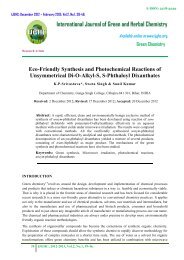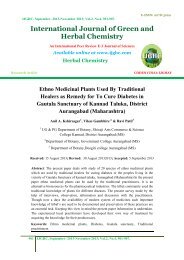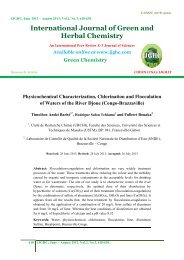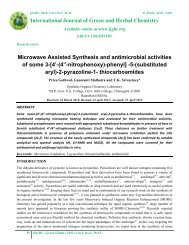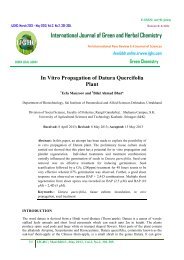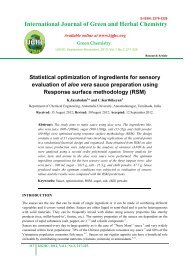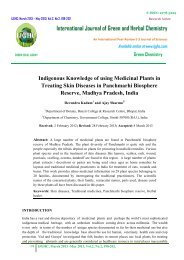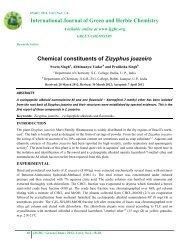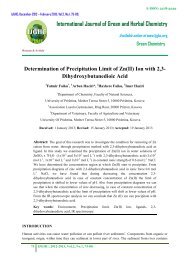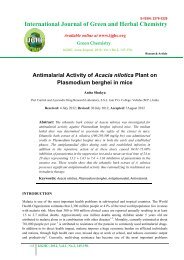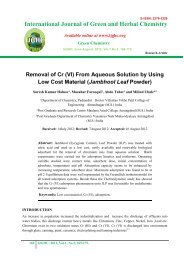Microwave Assisted Synthesis of Novel Benzotriazole - IJGHC
Microwave Assisted Synthesis of Novel Benzotriazole - IJGHC
Microwave Assisted Synthesis of Novel Benzotriazole - IJGHC
You also want an ePaper? Increase the reach of your titles
YUMPU automatically turns print PDFs into web optimized ePapers that Google loves.
E-ISSN: 2278-3229<br />
International Journal <strong>of</strong> Green and Herbal Chemistry<br />
Available online at www.ijghc.org<br />
Green Chemistry<br />
<strong>IJGHC</strong>; June-August, 2012; Vol.1.No.2, 108-119<br />
Research Article<br />
<strong>Microwave</strong> <strong>Assisted</strong> <strong>Synthesis</strong> <strong>of</strong> <strong>Novel</strong> <strong>Benzotriazole</strong><br />
- Pyrazoline derivatives and its Pharmacological<br />
Evaluation<br />
Kalmendra Singh Sisodiya 1 *, Manisha 2 , Amit Sahu 3 , V.K.Sharma 4 and Bharat Parashar 5<br />
1 Department <strong>of</strong> Chemistry, Pacific University, Udaipur, India.<br />
2 Skyline Institute <strong>of</strong> Engineering and Technology, Greater Noida (U.P.), India<br />
3 Department <strong>of</strong> Chemistry, Techno India NJR instituted <strong>of</strong> technology Udaipur, India<br />
4 Department <strong>of</strong> Chemistry, M.L. Sukhadia University, Udaipur, (Rajasthan)<br />
5 Department <strong>of</strong> pharmaceutics, M.B.University; Solan (H.P.).<br />
Received: 13 March 2012; Revised: 31 March 2012; Accepted: 8 April 2012<br />
Abstract: A solvent free approach for organic synthesis is described here which<br />
involve microwave exposure <strong>of</strong> neat reactants. A novel and simple method have<br />
been developed for the synthesis <strong>of</strong> some <strong>Benzotriazole</strong> - Pyrazoline derivatives<br />
under microwave irradiation. In addition, these compounds were obtained with<br />
conventional heating procedures and microwave irradiation to compare them<br />
with those obtained with solid support synthesis. All the compounds synthesized<br />
were characterized by running TLC, Elemental analysis, IR, NMR and MS<br />
spectra. Consequently, the solid support synthesis method provided nearly the<br />
same and higher product yields in a very short period <strong>of</strong> time. These results<br />
suggest that in addition, the use <strong>of</strong> solid supports in conjunction with microwave<br />
leads to a higher yield, remarkable reactions rate enhancement and high<br />
catalytic activity with the optimum utilization <strong>of</strong> energy. Solid support synthesis<br />
method is more useful than the microwave irradiation method and conventional<br />
method.<br />
Keywords: Green chemistry, microwave irradiation, solid supported synthesis,<br />
benzotriazole - pyrazoline derivatives, neat reaction technology<br />
108 <strong>IJGHC</strong>; 2012, Vol.1, No.2, 108-119.
<strong>Microwave</strong>...<br />
Kalmendra Singh et al.<br />
INTRODUCTION<br />
Classical methods require elaborate apparatus setup, longer heating time and large volume <strong>of</strong> organic<br />
solvents and there is virtually no control over the energy input. Hazardous chemicals and by products <strong>of</strong><br />
various reactions increasing pollution in the environment. Keeping in view the need for avoiding<br />
hazardous chemicals and solvents in chemical reactions, microwave technique was found to be<br />
accelerating a wide variety <strong>of</strong> transformations. Neat reaction technology is a step forward in the direction<br />
<strong>of</strong> solvent free reactions and an alternative approach that eliminates the use <strong>of</strong> a solid support as well as<br />
solvent from the reaction. In recent years design <strong>of</strong> environmentally benign reactions is an important goal<br />
in organic synthesis. <strong>Microwave</strong> induced Organic Reaction Enhancement (MORE) chemistry <strong>of</strong>fers a<br />
simple, non-conventional technique for the synthesis <strong>of</strong> a wide variety <strong>of</strong> compounds having medicinal,<br />
pharmaceutical and commercial importance. In this expeditious and solvent free approach the reactants<br />
were adsorbed over inorganic supports and exposed to microwave irradiation. In recent years the use <strong>of</strong><br />
microwaves 1,2 has been well established as a pollution free technique which allows reaction to occur on a<br />
preparative scale in open vessels under solvent free conditions which avoids the risk <strong>of</strong> high pressures and<br />
explosions. <strong>Microwave</strong> activation rather than conventional heating is preferred, as solid supports are rather<br />
poor thermal conductors but strong microwave absorbents, which results in lesser evaporation <strong>of</strong> solvents<br />
preventing pollution 3. Further the reactions are generally faster and the products obtained are <strong>of</strong> high<br />
purity 4, 5 .<br />
Pyrazole as well as pyrazolines containing compounds have been reported to show a broad spectrum <strong>of</strong><br />
biological activities such as antimicrobial 6-9 , anti-tumor 10, and antiinflammatory 11, 12 agents. Due to<br />
bioactivity associated with pyrazole and pyrazolines containing compounds, researchers and chemist are<br />
very much interested in pyrazole chemistry 13-15 . Pyrazolone are associated with broad spectrum <strong>of</strong><br />
biological activities 16 , Pyrazolone exhibit anti-inflammatory 17 and analagics activity 18 , anticancer<br />
activity 19 , 20 antiamoebic activity 21 , antitubercular activity 22 and antitumor activity 23 .<br />
<strong>Synthesis</strong> <strong>of</strong> some <strong>Benzotriazole</strong> - Pyrazoline derivatives under microwave irradiation using diethyl<br />
malonate, acetyl acetone, 1- Chloro-hexane 2-4 dione, ethyl 2-cyanoacetate and phenyl isothiocynate by<br />
solid support synthesis method, conventional heating procedures and microwave irradiation method were<br />
done. The reaction carrierd out in absolute alcohol or DMF using conventional method required 4-10 h,<br />
while microwave irradiation method require only 3.30-7 min and solid support method using silica gel<br />
require only 4-6.50 min. The synthetic route <strong>of</strong> above mentioned compound is shown in Scheme 1,<br />
(Table 1).<br />
MATERIALS AND METHODS<br />
Experimental Section: All the irradiation was carried out in a modified microwave oven (Kenstar, model<br />
no: OM26.EGO). Melting points <strong>of</strong> synthesis compounds were determined in open capillaries in liquid<br />
paraffin and are uncorrected. Purity <strong>of</strong> the compounds in addition to elemental analysis were verified by<br />
percolated TLC using silica gel G as a adsorbent using ethyl acetate: n-hexane (7:3) as a eluent and spot<br />
was detected by using iodine vapours. The IR (KBr pellets) spectra were recorded on a Perkin Elimer-<br />
1800- spectrophotometer and H 1 NMR spectra were recorded on BRUKER DRX-300MHz<br />
spectrophotometer, (TMS as a internal reference) and chemical shifts are expressed in δ. Mass spectra<br />
were recorded on Jeol D30 spectrophotometer. Elemental analyses for C, H and N were conducted using a<br />
Perkin -Elmer C, H, and N analyzer. Their result was found to be an in good agreement with the<br />
calculated values (±0.4%).<br />
<strong>Synthesis</strong> <strong>of</strong> ethyl 2-(1H-benzo[d][1,2,3]triazol-1-yl) acetate (I)<br />
Conventional Method: A mixture <strong>of</strong> <strong>Benzotriazole</strong> (0.01 mol), ethyl chloro acetate ( 0.01 mol) and<br />
potassium carbonate 3.0 gm in acetone 50.0 mL was stirred for 6 hours. Completion <strong>of</strong> reaction was 5<br />
109 <strong>IJGHC</strong>; 2012, Vol.1, No.2, 108-119.
<strong>Microwave</strong> ...<br />
Kalmendra Singh et al.<br />
<strong>Synthesis</strong> <strong>of</strong> Compound (I) and (II)<br />
HN<br />
N<br />
N<br />
+<br />
O<br />
O<br />
Cl<br />
K 2 CO 3<br />
N<br />
N<br />
N<br />
O -<br />
H 2 N NH<br />
NH 2 NH 2 .H 2 O<br />
N<br />
N<br />
N<br />
O<br />
( I ) (II)<br />
O<br />
Scheme No. 1<br />
O<br />
N<br />
H 3 C<br />
N<br />
N<br />
O<br />
O<br />
N<br />
N<br />
(2)<br />
O<br />
O<br />
N HN<br />
N<br />
N<br />
N<br />
CH 2 (COOC 2 H 5 ) 2<br />
O<br />
S<br />
O<br />
N<br />
N<br />
(E)-N-(4-oxo-2-(phenylimino)thiazolidin-3-<br />
yl)-1H-benzo[d][1,2,3]triazole-1-<br />
carboxamide<br />
O<br />
NH<br />
N N N<br />
CH 3 COOH<br />
Cl<br />
O<br />
N<br />
N<br />
N<br />
N<br />
N<br />
(4)<br />
O<br />
N<br />
N<br />
(3)<br />
O<br />
N<br />
N<br />
N<br />
CH 3<br />
2-(1H-benzo[d][1,2,3]triazol-1-<br />
yl)-1-(3,5-dimethyl-4,5-<br />
dihydropyrazol-1-yl)ethanone<br />
CH 3 COCH 2 COCH 3<br />
ClCH 2 COCH 2 COCH 2 CH 3<br />
1-(2-(1H-benzo[d][1,2,3]triazol-<br />
1-yl)acetyl)-3-(chloromethyl)-<br />
1H-pyrazol-5(4H)-one<br />
(5)<br />
N<br />
N<br />
N<br />
CH 2 (COOC 2 H 5 ) 2<br />
N<br />
C 6 H 5 NCS<br />
N<br />
H 2 N<br />
NH<br />
N<br />
(II)<br />
O<br />
2-(1H-<br />
benzo[d][1,2,3]triazol-1-<br />
yl)acetohydrazide<br />
H 3 C<br />
N<br />
N<br />
CH 3 COCH 2 COCH 2 CH 3<br />
O<br />
O<br />
CNCH 2 COOCH 2 CH 3<br />
H 2 N<br />
O<br />
(8)<br />
N N N<br />
N<br />
O<br />
N<br />
(i)Morpholine<br />
(ii)ClCH 2 COOC 2 H 5<br />
H<br />
N<br />
N<br />
H<br />
O<br />
1-(2-(1H-<br />
benzo[d][1,2,3]triazol-1-<br />
yl)acetyl)pyrazolidine-3,5-<br />
dione<br />
(1)<br />
1-(2-(1H-benzo[d][1,2,3]triazol-1-<br />
yl)acetyl)-2-acetylpyrazolidine-3,5-<br />
dione<br />
1-(2-(1H-benzo[d][1,2,3]triazol-1-<br />
yl)acetyl)-4-phenylthiosemicarbazide<br />
O<br />
HN<br />
1-(2-(1H-benzo[d][1,2,3]triazol-1-<br />
yl)acetyl)-3-methyl-1H-pyrazol-5(4H)-<br />
one<br />
1-(2-(1H-benzo[d][1,2,3]triazol-1-yl)acetyl)-<br />
3-amino-1H-pyrazol-5(4H)-one<br />
(7)<br />
(6)<br />
S<br />
N<br />
N<br />
N<br />
Scheme-2<br />
The synthetic route <strong>of</strong> compounds (1-8)<br />
110 <strong>IJGHC</strong>; 2012, Vol.1, No.2, 108-120.
<strong>Microwave</strong>...<br />
Kalmendra Singh et al.<br />
Table: 1- Comparative Analysis <strong>of</strong> Conventional and <strong>Microwave</strong> Methods<br />
Comp<br />
Molecular<br />
formula<br />
M.wt Condition Conventional<br />
method<br />
Yield<br />
(%)<br />
R time(h)<br />
<strong>Microwave</strong> method m.<br />
p<br />
o C<br />
In solvent On Solid<br />
Yield<br />
(%)<br />
R time<br />
(min)<br />
Support<br />
Yield<br />
(%)<br />
R time<br />
(min)<br />
1 C 11 H 9 N 5 O 3 259 A.A 70 6.00 82 3.00 88 6.10 17<br />
2<br />
2 C 13 H 11 N 5 O 4 301 A.A 68 5.10 80 5.10 86 6.30 18<br />
9<br />
3 C 13 H 13 N 5 O 257 - 71 8.10 84 3.10 90 3.30 16<br />
9<br />
4 C 12 H 10 ClN 5 O 2 291 - 72 5.22 81 3.30 88 5.30 20<br />
1<br />
5 C 12 H 11 N 5 O 2 257 A.A 71 6.12 83 3.00 90 5.20 16<br />
9<br />
6 C 11 H 10 N 6 O 2 258 - 73 4.55 84 3.00 92 2.20 18<br />
2<br />
7 C 15 H 14 N 6 OS 326 - 69 4.11 82 2.00 90 2.10 21<br />
0<br />
8 C 16 H 12 N 6 O 2 S 352 Morpholin 70 5.50 80 2.30 86 3.10 23<br />
e<br />
2<br />
A.A= Acetic acid<br />
R f<br />
0.64<br />
0.62<br />
0.68<br />
0.61<br />
0.68<br />
0.66<br />
0.66<br />
0.66<br />
<strong>Synthesis</strong> <strong>of</strong> 1-(2-(1H-benzo[d][1,2,3]triazol-1-yl) acetyl)pyrazolidine-3,5-dione. (1)<br />
Conventional Method: A mixture <strong>of</strong> (II) (0.01 mol), diethyl malonate (0.01mol) and two to three drops <strong>of</strong><br />
glacial acetic acid were taken in a round bottom flask in 50 mL <strong>of</strong> ethyl alcohol and was refluxed for<br />
about 6 hr on a water bath. After completion <strong>of</strong> the reaction as indicated by TLC, the reaction mixture was<br />
cooled and treated with ice cold water. The brown colour oily mass obtained was cooled and the crud<br />
product was recrystallized from ethanol to give afford 1. Physical characteristic <strong>of</strong> compound is recorded<br />
in Table No 1.<br />
<strong>Microwave</strong> Method in solvent: A mixture <strong>of</strong> (II) (0.01 mol), diethyl malonate (0.01mol) and two to<br />
three drops <strong>of</strong> glacial acetic acid in 30 mL <strong>of</strong> ethyl alcohol was subjected to microwave irradiation at 360<br />
W for 3 min with an intermittently at 30 sec intervals. After completion <strong>of</strong> the reaction as indicated by<br />
TLC, the reaction mixture was cooled and treated with cold water. The brown colour oily mass obtained<br />
was cooled and the crud product was recrystallized from ethanol to give afford 1. Physical characteristic<br />
<strong>of</strong> compound is recorded in Table No 1.<br />
Solid Support Method: A mixture <strong>of</strong> (II) (0.01 mol), diethyl malonate (0.01mol) were dissolve in alcohol<br />
and the mixture was absorbed on acidic alumina and was subjected to microwave irradiation at 500 W for<br />
5.10 min with an intermittently at 10 sec intervals. After completion <strong>of</strong> the reaction as indicated by TLC,<br />
the compound was separate out from di ethylethane and recrystallise from ethyl alcohol. Physical<br />
characteristic <strong>of</strong> compound is recorded in Table No 1.<br />
Physical and Elemental Analysis <strong>of</strong> Compound 1: Mol. Wt. 259; M.P. 172-174 °C; Yield: 88 %; R f<br />
:0.64; IR ( KBr cm -1 ): 3303 (-NH), 3035 (Aromatic CH-Ar. str. ), 2260 (N=N), 1735, 1730,<br />
1666,(C=O), ; 1 H NMR (400 MHz, DMSO-d 6 ) : 7.45- 7.80 (4H, m, Ar-H); 8.70 (s, H, NH), 4.75 (s,<br />
111 <strong>IJGHC</strong>; 2012, Vol.1, No.2, 108-119.
<strong>Microwave</strong> ...<br />
Kalmendra Singh et al.<br />
2H, CH 2 ) , 3.35 (s, 2H, CH 2 ), MS (m/z+) [M + ] 259; Anal.Calc.for C 11 H 9 N 5 O 3 ; C, 50.97; H, 3.50; N,<br />
27.02; Found: C, 51.26.; H, 3.30; N, 26.82.<br />
<strong>Synthesis</strong> <strong>of</strong> 1- (2- (1H-benzo [d][1,2,3] triazol-1-yl)acetyl) -2-acetylpyrazolidine -3,5-dione<br />
(2)<br />
Conventional Method: A mixture <strong>of</strong> (II) (0.01 mol) and diethyl malonate (0.01 mol) in glacial acetic<br />
acid (5 mL) were taken in a round bottom flask and was refluxed for about 5 hr on a water bath . After<br />
completion <strong>of</strong> the reaction as indicated by TLC, the reaction mixture was cooled and treated with cold<br />
water. The solid that precipitated was filtered, washed with water and recrystallized from ethanol to<br />
afford 2. Physical characteristic <strong>of</strong> compound is recorded in Table No 1.<br />
<strong>Microwave</strong> Method in solvent: A mixture <strong>of</strong> (II) (0.01 mol) and diethyl malonate (0.01 mol) in glacial<br />
acetic acid (5 mL) was subjected to microwave irradiation at 360 W for 5.10 min with an intermittently at<br />
20 sec intervals. After completion <strong>of</strong> the reaction as indicated by TLC, the reaction mixture was cooled<br />
and treated with cold water. The solid that precipitated was filtered, washed with water and recrystallized<br />
from ethanol to afford 2. Physical characteristic <strong>of</strong> compound is recorded in Table No 1.<br />
<strong>Microwave</strong> Method on Solid Support: Compound (II) (0.01 mol) and diethyl malonate (0.01 mol) were<br />
dissolved in acetone and the solution was absorbed on acidic alumina and was subjected to microwave<br />
irradiation at 500 W for 4.30 min with an intermittently at 10 sec intervals . After completion <strong>of</strong> the<br />
reaction as indicated by TLC compound was separate out from acetone and allows drying. Product was<br />
recrystallised with di methyl ether to afford 2. Physical characteristic <strong>of</strong> compound is recorded in Table<br />
No 1.<br />
Physical and Spectral Analysis <strong>of</strong> Compound 2: Mol. Wt. 301; M.P. 189-191 °C; Yield: 86 %; R f :0.62;<br />
IR ( KBr cm -1 ): 3130 (Aromatic CH-Ar, str. ), 2270 (N=N), 1740,1693, 1670, 1640, (C=O), ; 1 H NMR<br />
(400 MHz, DMSO-d 6 ) : 7.32- 7.82 (4H, m, Ar-H); 4.60 (s, 2H, CH 2 ) , 3.30 (s, 2H, CH 2 ), 2.40 (s, 3H,<br />
CH 3 ) : MS (m/z+) [M + ] 301; Anal. Calc.for C 13 H 11 N 5 O 4 ; C, 51.83; H, 3.68; N, 23.25; Found: C,<br />
52.06.; H, 4.02; N, 23.72;<br />
<strong>Synthesis</strong> <strong>of</strong> 2- (1H-benzo [d][1,2,3 ]triazol-1-yl) -1- (3,5-dimethy l-4,5-dihydropyrazol-1-yl)<br />
ethanone(3)<br />
Conventional Method: A mixture <strong>of</strong> 2-(1H-benzo[d][1,2,3]triazol-1-yl) acetohydrazide (II) (0.01 mol)<br />
and acetyl acetone (0.01 mol) was taken in Erlenmeyer flask. The mixture was well stirred and then taken<br />
in a round bottom flask and was refluxed for about 2 hr on a water bath. After completion <strong>of</strong> the reaction<br />
as indicated by TLC the reaction- mixture was then allowed to stand at RT and the product formed was<br />
washed with cold water and dissolved in methanol then filtered, dried and recrystallized from ethanol to<br />
afford 3. Physical characteristic <strong>of</strong> compound is recorded in Table No 1.<br />
<strong>Microwave</strong> Method in solvent: A mixture <strong>of</strong> 2-(1H-benzo[d][1,2,3]triazol-1-yl) acetohydrazide (II) (0.01<br />
mol) and acetyl acetone (0.01 mol) was taken in Erlenmeyer flask. The mixture was well stirred subjected<br />
to microwave irradiation at 360 W for 3.10 min with an intermittently at 10 sec intervals. After<br />
completion <strong>of</strong> the reaction as indicated by TLC the reaction- mixture was then allowed to stand at RT and<br />
the product formed was washed with cold water and dissolved in methanol then filtered, dried and<br />
recrystallized from ethanol to afford 3. Physical characteristic <strong>of</strong> compound is recorded in Table No 1.<br />
<strong>Microwave</strong> Method on Solid Support: A solution <strong>of</strong> (II) (0.01 mol) and acetyl acetone (0.01 mol) were<br />
taken in beaker. The mixture was well stirred and then absorbed on neutral alumina and was subjected to<br />
microwave irradiation at 500 W for 3.10 min with an intermittently at 20-25 sec intervals. After<br />
completion <strong>of</strong> the reaction as indicated by TLC the compound was separate out from acetone and<br />
recrystallized from ethanol to afford 3. Physical characteristic <strong>of</strong> compound is recorded in Table No 1.<br />
112 <strong>IJGHC</strong>; 2012, Vol.1, No.2, 108-120.
<strong>Microwave</strong>...<br />
Kalmendra Singh et al.<br />
Physical and Spectral Analysis <strong>of</strong> Compound 3: Mol. Wt. 257; M.P. 169-171 °C; Yield: 90 %; R f :0.68;<br />
IR ( KBr cm -1 ): 3110 (Aromatic CH-Ar, str. ), 2265 (N=N), 1690, (C=O), 1553(C=N), : 1 H NMR (400<br />
MHz, DMSO-d 6 ) : 7.32- 7.82 (4H, m, Ar-H); 5.71(s, 1H, CH) , 4.56 (s, 2H, CH 2 ) , 3.42 (s, 2H, CH 2 ),<br />
3.35 (s, 3H, CH 3 ), 2.40 (s, 3H, CH 3 ): MS (m/z+) [M + ] 257 ; Anal. Calc.for C 13 H 13 N 5 O; C, 60.69; H,<br />
5.88; N, 27.22; Found: C, 60.92; H, 5.62; N, 27.50.<br />
<strong>Synthesis</strong> <strong>of</strong> 1-(2-(1H-benzo[d][1,2,3]triazol-1-yl)acetyl)-3-(chloromethyl)-1H-pyrazol-<br />
5(4H)-one (4)<br />
Conventional Method: A mixture <strong>of</strong> (II) (0.01 mol), 1- Chloro-hexane 2-4 dione (0.012 mol) was taken<br />
in a round bottom flask and was refluxed for about 5 hr on a water bath. TLC monitored the reaction.<br />
After completion <strong>of</strong> the reaction, reaction- mixture was allowed to stand at RT and the product formed<br />
was filtered, washed with water, dried and recrystallized from ethanol to afford 4. Physical characteristic<br />
<strong>of</strong> compound is recorded in Table No 1.<br />
<strong>Microwave</strong> Method in solvent: A mixture <strong>of</strong> (II) (0.01 mol), 1- Chloro-hexane 2-4 dione (0.07 mol) was<br />
taken in a borosil beaker (100 mL). The well-stirred mixture was irradiated inside the microwave oven for<br />
a period <strong>of</strong> 3.30 minutes (at 480 W). TLC monitored the reaction. After completion <strong>of</strong> the reaction,<br />
reaction- mixture was allowed to stand at RT and the product formed was filtered, washed with water,<br />
dried and recrystallized from ethanol to afford 4. Physical characteristic <strong>of</strong> compound is recorded in Table<br />
No 1.<br />
<strong>Microwave</strong> Method on Solid Support: Compound (II) (0.01 mol), 1- Chloro-hexane 2-4 dione (0.07<br />
mol) were dissolved in alcohol and the mixture was absorbed on neutral alumina and was irradiated inside<br />
the microwave oven for a period <strong>of</strong> 5.30 minutes (at 500W). TLC monitored the reaction. After<br />
completion <strong>of</strong> the reaction, product was separate out from aceton recrystallized from ethanol to afford 4.<br />
Physical characteristic <strong>of</strong> compound is recorded in Table No 1.<br />
Physical and Spectral Analysis <strong>of</strong> Compound 4: Mol. Wt. 291; M.P. 201-122 °C; Yield: 88 %; R f :0.61;<br />
IR ( KBr cm -1 ): 3080 (Aromatic CH-Ar str. ), 2240 (N=N), 1695,1666 (C=O), 1606 (C=N), : 1 H NMR<br />
(400 MHz, DMSO-d 6 ) : 7.7-7.8(m, 4H,), 2.80 (s, 2H, CH 2 ), 3.45 (s, 2H, CH 2 ): 7.32- 7.82 (4H, m, Ar-H);<br />
5.71(s, 1H, CH) , 4.30 (s, 2H, CH 2 ) , 3.22 (s, 2H, CH 2 ), : MS (m/z+) [M + ] 291 ; Anal. Calc.for C 12 H 10<br />
ClN 5 O 2 ; C, 49.41; H, 3.46; N, 24.01; Found: C, 49.64; H, 3.16; 1-; N, 24.24.<br />
<strong>Synthesis</strong> <strong>of</strong> 1-(2-(1H-benzo[d][1,2,3]triazol-1-yl)acetyl)-3-methyl-1H-pyrazol--(4H)-one (5)<br />
Conventional Method: Compound (II), hexane-2, 4-dione (0.01 mol), and (0.005 mol) acetic acid was<br />
mixed thoroughly. This mixture was taken in a round bottom flask and was refluxed for about 6 hr on a<br />
water bath. Upon completion <strong>of</strong> the reaction (monitored by TLC), the reaction mixture was poured onto<br />
crushed ice. The solid mass obtained was filtered and washed several times with water. Purification by<br />
recrystallization with alcohol gave product 5. Physical characteristic <strong>of</strong> compound is recorded in Table<br />
No 1.<br />
<strong>Microwave</strong> Method in solvent: Compound (II), hexane-2, 4-dione (0.01 mol), and (0.00- mol) acetic<br />
acid was mixed thoroughly. This mixture was subjected to microwave irradiation (by keeping inside a<br />
microwave oven) for 3.0 min at 480 W power levels with intermitted irradiation for 30 second. Upon<br />
completion <strong>of</strong> the reaction (monitored by TLC), the reaction mixture was poured onto crushed ice. The<br />
solid mass obtained was filtered and washed several times with water. Purification by recrystallization<br />
with alcohol gave product 5. Physical characteristic <strong>of</strong> compound is recorded in Table No 1.<br />
<strong>Microwave</strong> Method on Solid Support: Compound (II), hexane-2,4-dione (0.01 mol), were dissolved in<br />
acetone and absorbed on acidic alumina and irradiated inside the microwave oven for a period <strong>of</strong> 5.20 min<br />
at 500 W power levels with intermitted irradiation for 30 second. Upon completion <strong>of</strong> the reaction<br />
(monitored by TLC), the reaction mixture was poured onto crushed ice. The solid mass obtained was<br />
113 <strong>IJGHC</strong>; 2012, Vol.1, No.2, 108-119.
<strong>Microwave</strong> ...<br />
Kalmendra Singh et al.<br />
filtered and washed several times with water. Purification by recrystallization with alcohol gave product 5.<br />
Physical characteristic <strong>of</strong> compound is recorded in Table No 1.<br />
Physical and Spectral Analysis <strong>of</strong> Compound 5: Mol. Wt. 257; M.P. 169-171 °C; Yield: 90 %; R f :0.68;<br />
IR ( KBr cm -1 ): 3115 (Aromatic CH-Ar str. ), 2262 (N=N), 1680, 1606 (C=O), 1530 (C=N), ; 1 H<br />
NMR (400 MHz, DMSO-d 6 ) : 7.40- 7.88 (4H, m, Ar-H); 4.56 (s, 2H, CH 2 ) , 3.42 (s, 2H, CH 2 ), 3.35 (s,<br />
3H, CH 3 ), : MS (m/z+) [M + ] 257 ; Anal. Calc.for C 12 H 11 N 5 O 2 ; C, 56.03; H, 4.31; N, 27.22; Found: C,<br />
56.36; H, 4.64; N, 27.46.<br />
<strong>Synthesis</strong> <strong>of</strong> 1-(2-(1H-benzo[d][1,2,3]triazol-1-yl)acetyl)-3-amino-1H-pyrazol--(4H)-one (6)<br />
Conventional Method: 2-(1H-benzo[d][1,2,3]triazol-1-yl) acetohydrazide (0.01 mol) (II)and (0.01) and<br />
ethyl 2-cyanoacetate (0.01) in -0 mL ethanol were taken in a round bottom flask and was refluxed for<br />
about 4hr on a water bath and reaction progress was monitored by TLC. Then crude product so obtained<br />
was poured into ice-cold water, filtered, dried, and recrystallized from methanol to give product 6.<br />
Physical characteristic <strong>of</strong> compound is recorded in Table No 1.<br />
<strong>Microwave</strong> Method in solvent: 2-(1H-benzo[d][1,2,3]triazol-1-yl) acetohydrazide (0.01 mol) (II) and<br />
(0.01) and ethyl 2-cyanoacetate (0.01) were mixed together to form a paste and then subjected to<br />
microwave irradiation for 3.0 min at 400 W power level and reaction progress was monitored by TLC.<br />
Then crude product so obtained was poured into ice-cold water, filtered, dried, and recrystallized from<br />
methanol to give product 6. Physical characteristic <strong>of</strong> compound is recorded in Table No 1.<br />
Solid Support Method: 2-(1H-benzo[d][1,2,3]triazol-1-yl) acetohydrazide (0.01 mol) (II) and (0.01) and<br />
ethyl 2-cyanoacetate (0.01) were dissolved in alcohol and absorbed on alumina. The mixture was<br />
subjected to microwave irradiation at 500 W for 4.20 min with an intermittently at 30-35 sec intervals.<br />
After completion <strong>of</strong> the reaction indicated by TLC the compound was separate out from acetone and<br />
recrystallize from alcohol to give product 6. Physical characteristic <strong>of</strong> compound is recorded in<br />
Table No 1.<br />
Physical and Spectral Analysis <strong>of</strong> Compound 6: Mol. Wt. 258; M.P. 182-183 °C; Yield: 92 %; R f :0.66;<br />
IR ( KBr cm -1 ): 3334, 3218(-NH 2 ), 3140 (Aromatic CH-Ar str. ), 2262 (N=N), 1698, 1672 (C=O),<br />
1554 (C=N), ; 1 H NMR (400 MHz, DMSO-d 6 ) : 7.46- 7.68 (4H, m, Ar-H); 5.12 (s, 2H, NH2), 4.50 (s,<br />
2H, CH 2 ) , 3.42 (s, 2H, CH 2 ),: MS (m/z+) [M + ] 258 ; Anal. Calc.for C 11 H 10 N 6 O 2 ; C, 51.16; H, 3.90; N,<br />
32.54; Found: C, 51.36; H, 4.20; N, 32.74.<br />
<strong>Synthesis</strong> <strong>of</strong> 1-(2-(1H-benzo[d][1,2,3]triazol-1-yl)acetyl)-4-phenylthiosemicarbazide (7)<br />
Conventional Method: To a mixture <strong>of</strong> 2-(1H-benzo[d][1,2,3]triazol-1-yl) acetohydrazide (II) (0.01 mol )<br />
and phenyl isothiocynate (0.01 mol e) in a 40 ml DMF was were taken in a round bottom flask and was<br />
refluxed for about 4 hr on a water bath. TLC examined the progress <strong>of</strong> the reaction. The mixture was<br />
poured into ice-cold water. The resulting solid was filtered, dried and recrystallized from benzene to give<br />
product 7. Physical characteristic <strong>of</strong> compound is recorded in Table No 1.<br />
<strong>Microwave</strong> Method in solvent: To a mixture <strong>of</strong> 2-(1H-benzo[d][1,2,3]triazol-1-yl) acetohydrazide (II)<br />
(0.01 mol ) and phenyl isothiocynate (0.01 mol e) in a 20 ml DMF was taken in Erlenmeyer flask. The<br />
mixture was irradiated under microwave for 2.00 min at 360 W powers with intermittent radiation <strong>of</strong> 15<br />
sec interval. TLC examined the progress <strong>of</strong> the reaction. The mixture was poured into ice-cold water. The<br />
resulting solid was filtered, dried and recrystallized from benzene to give product 7. Physical<br />
characteristic <strong>of</strong> compound is recorded in Table No 1.<br />
<strong>Microwave</strong> Method on Solid Support: 2-(1H-benzo[d][1,2,3]triazol-1-yl) acetohydrazide (II) (0.01 mol)<br />
and phenyl isothiocynate (0.01 mol) were dissolved in acetone and the mixture was absorbed on neutral<br />
alumina and was subjected to microwave irradiation at 500 W for 5.10 min with an intermittently at 15-20<br />
sec intervals. After completion <strong>of</strong> the reaction the compound was separate out from acetone and<br />
114 <strong>IJGHC</strong>; 2012, Vol.1, No.2, 108-120.
<strong>Microwave</strong>...<br />
Kalmendra Singh et al.<br />
recrystallize from alcohol to give product 7. Physical characteristic <strong>of</strong> compound is recorded in<br />
Table No 1.<br />
Physical and Spectral Analysis <strong>of</strong> Compound 7: Mol. Wt. 326; M.P. 210-2111 °C; Yield: 90 %; R f<br />
:0.66; IR ( KBr cm -1 ): 3416,3372, 3312(-NH), 3089 (Aromatic CH-Ar str. ), 2262 (N=N), 1708 (C=O),<br />
1100 (C=S), ; 1 H NMR (400 MHz, DMSO-d 6 ) : 10.20 (s,H, HN-CO), 7.48- 7.80 (m, 9H, Ar-H); 4.34<br />
(s,H,HN-Ph), 3.42 (s, 2H, CH 2 ), 2.20 (s,H,HN-N); : MS (m/z+) [M + ] 326 ; Anal. Calc.for; C 15 H 14 N 6 OS<br />
; C, 55.20; H, 4.32; N, 25.75; Found: C, 55.20; H, 4.32; N, 25.75.<br />
<strong>Synthesis</strong> <strong>of</strong> (E) -N- (4-oxo-2-(phenylimino) thiazolidin-3-yl)-1H-benzo[d][1,2,3]triazole-1-<br />
carboxamide (8)<br />
Conventional Method: A mixture <strong>of</strong> 7 (0.01 mol) and ethylchloroacetate in presence <strong>of</strong> catalytic amount<br />
<strong>of</strong> morpholine in 40 mL <strong>of</strong> ethanol were taken in a round bottom flask and was refluxed for about 5.50 hr<br />
on a water bath. After completion <strong>of</strong> the reaction as indicated by TLC, the reaction mixture was cooled<br />
and treated with ice-cold water and recrystallized from ethanol to give product 8. Physical characteristic<br />
<strong>of</strong> compound is recorded in Table No 1.<br />
<strong>Microwave</strong> Method in solvent: A mixture <strong>of</strong> 7 (0.01 mol) and ethylchloroacetate in presence <strong>of</strong> catalytic<br />
amount <strong>of</strong> morpholine were mixed thoroughly. Than the mixture was irradiated under microwave oven for<br />
2.30 min at 480 W with an intermitted irradiation for 30sec. interval. After completion <strong>of</strong> the reaction as<br />
indicated by TLC, the reaction mixture was cooled and treated with ice-cold water and recrystallized from<br />
ethanol to give product 8. Physical characteristic <strong>of</strong> compound is recorded in Table No 1.<br />
<strong>Microwave</strong> Method on Solid Support: A mixture <strong>of</strong> 7 (0.01 mol) and ethylchloroacetate were mixed<br />
thoroughly and dissolved in alcohol and the mixture was absorbed on basic alumina and subjected to<br />
microwave irradiation at500 W for 4.10 min with an intermittently at 15-20 sec intervals. After<br />
completion <strong>of</strong> the reaction as indicated by TLC the compound was separate out from acetone and 1,2<br />
dichloro methane. Physical characteristic <strong>of</strong> compound is recorded in Table No 1.<br />
Physical and Spectral Analysis <strong>of</strong> Compound 8: Mol. Wt. 352; M.P. 232-334 °C; Yield: 86 %; R f :0.66;<br />
IR ( KBr cm -1 ): 3080 (Aromatic CH-Ar str. ), 2282 (N=N), 1698, 1649 (C=O), 740 (S-C-S), ; 1 H NMR<br />
(400 MHz, DMSO-d 6 ) : 10.20 (s, H, HN-CO), 9.67(s, H, HN) , 7.32- 7.88 (m, 9H, Ar-H); 4.10 (s, 2H,<br />
CH 2 ), : MS (m/z+) [M + ] 352 ; Anal. Calc. for; C 16 H 12 N 6 O 2 S; C, 54.54; H, 3.43; N, 23.85; Found: C,<br />
54.74; H, 3.24; N, 23.62.<br />
BIOLOGICAL ASSAY<br />
All the newly synthesized compounds were tested in vitro for antimicrobial activity against four bacterial<br />
strains two-gram positive bacteria (Bacillus subtilis and staphylococcus aureus) and two-gram negative<br />
bacteria (Escherichia coli and P.aeruginosa) and antifungal activity against Candida albicans and<br />
Asperigillus niger at the concentration <strong>of</strong> 200,100,50, µg/ml by using the cup plate agar disk diffusion<br />
method 24 , 25 and determination <strong>of</strong> minimum inhibitory concentration (MIC) by broth dilution method.The<br />
concentration used in screening was choosen after determining MIC <strong>of</strong> each compound. The<br />
dimethylsulfoxide (DMSO) was used as a solvent. For this method, Mueller-Hinton agar was used as the<br />
growth medium for the bacterial strains and Sabouraud agar was growth medium for fungal species. The<br />
sterilized agar media were poured in to petridishes and allow solidifying. On the surface <strong>of</strong> the media<br />
microbial suspension were spread with the help <strong>of</strong> sterilized triangular loop. (Inoculums <strong>of</strong> standard<br />
suspension 0.1 mL <strong>of</strong> the test organism strain which contains 106 bacilli/mL)<br />
A stainless steel cylinder <strong>of</strong> 9 mm diameter (pre sterilized) was used to bore the cavities. In to these well<br />
were added 0.1mL portion <strong>of</strong> the test compounds in solvent DMSO. The drug solution was allowed to<br />
diffuse for about an hour in to the medium. The petridishes used for antibacterial screening were<br />
115 <strong>IJGHC</strong>; 2012, Vol.1, No.2, 108-119.
<strong>Microwave</strong> ...<br />
Kalmendra Singh et al.<br />
incubated at 37 ±1°C for 24 h, while those for antifungal activity were incubated at 28 ±1°C for 48-72 h.<br />
DMSO was used as a control for all the type <strong>of</strong> microorganisms. The control showed no activity against<br />
the strains <strong>of</strong> microorganisms used. Antimicrobial activity and antifungal activity was measured as a<br />
function <strong>of</strong> diameter <strong>of</strong> zone <strong>of</strong> inhibition (mm). The result was compared with standard drugs<br />
Cipr<strong>of</strong>loxacin for antibacterial activity and fluconazole for antifungal activity by measuring the zone <strong>of</strong><br />
inhibition in mm at 200,100 and 50 µg/mL (Table -2 and Table-3). The lowest concentration, which<br />
showed no visible growth, was taken as an end point minimum inhibitory concentration (MIC). For<br />
antibacterial activity, in present protocol 50 µg/ml is considered as active as compared to the standard<br />
drug Cipr<strong>of</strong>loxacin. For antifungal activity, 50 µg/mL is considered as active as compared to standard<br />
fluconazole<br />
Table: 2. Antifungal Activities <strong>of</strong> the synthesized compounds (1-8).<br />
Antifungal activity<br />
Compounds C. albicans A. niger<br />
50µg<br />
/ml<br />
100<br />
µg/ml<br />
200<br />
µg/ml<br />
50µg<br />
/ml<br />
100µg<br />
/ml<br />
200µg<br />
/ml<br />
1 - ++ +++ - ++ ++<br />
2 + ++ ++++ ++ +++ ++++<br />
3 - ++ +++ - ++ +++<br />
4 + ++ ++ + ++ ++<br />
5 ++ ++ ++ ++ ++ ++<br />
6 ++ +++ +++ ++ ++ +++<br />
7 ++ +++ +++ +++ +++ +++<br />
8 + +++ +++ - ++ +++<br />
Fluconazole ++++ ++++ ++++ ++++ ++++ + + + +<br />
(-)< 6mm; (+) = 7 - 10 mm; (++) =11 – 15 mm; (+++) = 16 - 21mm; (++++) = 22 - 28mm.<br />
RESULTS AND DISCUSSIONS<br />
The compound ethyl 2-(1H-benzo[d][1,2,3]triazol-1-yl) acetate (I) was synthesized by microwave<br />
radiation <strong>of</strong> mixture <strong>of</strong> <strong>Benzotriazole</strong>, ethyl chloro acetate and potassium carbonate in acetone. The M.P.<br />
<strong>of</strong> the synthesized compound was checked by the given literature. The compound 2-(1Hbenzo[d][1,2,3]triazol-1-yl)<br />
acetohydrazide (II) was synthesized by ethanolic solution <strong>of</strong> compound (I)<br />
and hydrazine hydrate under microwave radiation <strong>of</strong> 240W. The purity <strong>of</strong> the compound was analyzed by<br />
TLC using ethyl acetate: n-hexane (7:3) as a mobile phase. The final compounds (1-8) were synthesized<br />
as given below. The structure <strong>of</strong> the synthesized compounds was confirmed on the basis <strong>of</strong> spectral and<br />
elemental analysis.<br />
The compound (1) 1-(2-(1H-benzo[d][1,2,3]triazol-1-yl) acetyl)pyrazolidine-3,5-dione is synthesized by<br />
irradiating mixture <strong>of</strong> compound (II), diethyl malonate and 2-3 drops <strong>of</strong> glacial acetic acid. The IR<br />
spectrum exhibited bands due to 1735, 1730, 1666 (C=O), and 1 H NMR gives δ shift at 4.75 (s, 2H, CH 2 ),<br />
3.35 (s, 2H, CH 2 o) and molecular ion peak [M + ] was found at 259 which confirmed the formation <strong>of</strong><br />
compound (1).<br />
The compound (2) 1-(2-(1H-benzo[d][1,2,3]triazol-1-yl)acetyl)-2-acetylpyrazolidine-3,5-dione was<br />
synthesized by irradiating mixture <strong>of</strong> compound (II), diethyl malonate and 5ml <strong>of</strong> glacial acetic acid. The<br />
IR spectrum exhibited bands due to 1740,1693,1670,1640 (C=O), 1 H NMR gives δ shift at 4.60 (s, 2H,<br />
CH 2 ) , 3.30 (s, 2H, CH 2 ), 2.40 (s, 3H, CH 3 ) molecular ion peak [M + ] was found at 301 which confirmed<br />
the formation <strong>of</strong> compound (2).<br />
116 <strong>IJGHC</strong>; 2012, Vol.1, No.2, 108-120.
<strong>Microwave</strong>...<br />
Kalmendra Singh et al.<br />
Table: 3. Antibacterial Activities <strong>of</strong> the synthesized compounds (1-8).<br />
Antibacterial activity<br />
Comp E. coli P. aeruginosa B. subtitis S. aureus<br />
ounds<br />
50<br />
µg<br />
/ml<br />
100<br />
µg<br />
/ml<br />
200<br />
µg<br />
/ml<br />
50<br />
µg<br />
/ml<br />
100<br />
µg<br />
/ml<br />
200<br />
µg<br />
/ml<br />
50<br />
µg<br />
/ml<br />
100<br />
µg<br />
/ml<br />
200<br />
µg<br />
/ml<br />
50<br />
µg<br />
/ml<br />
100<br />
µg<br />
/ml<br />
1 _ ++ ++ _ + ++ _ ++ ++ _ _ +<br />
2 _ ++ +++ _ _ + _ ++ +++ _ ++ +++<br />
3 + ++ ++++ _ ++ ++ _ ++ +++ _ ++ ++<br />
4 + +++ ++++ _ + ++ _ ++ ++++ _ ++ +++<br />
5 _ + +++ _ + +++ _ ++ ++ _ ++ +++<br />
6 _ ++ +++ _ + + _ ++ +++ _ _ +++<br />
7 _ + +++ _ + +++ _ ++ +++ _ + +++<br />
8 _ +++ ++++ + ++ +++ + ++ +++ _ + +++<br />
Cipr<strong>of</strong>l<br />
oxacin<br />
++++ ++++ ++++ ++++ ++++ ++++ ++++ ++++ ++++ ++++ ++++ ++++<br />
200<br />
µg<br />
/ml<br />
(-)< 6mm; (+) = 7 - 10 mm; (++) =11 – 15 mm; (+++) = 16 - 21mm; (++++) = 22 - 28mm.<br />
The compound (3) 2-(1H-benzo[d][1,2,3]triazol-1-yl)-1-(3,5-dimethyl-4,5-dihydropyrazol-1-yl)ethanone<br />
was synthesized by irradiating mixture <strong>of</strong> compound (II) and acetyl acetone. The IR spectrum exhibited<br />
bands due to 1553(C=N) , 1 H NMR (400 MHz, DMSO-d 6 ) showed peaks due to 3.35(s, 3H, CH 3 ), 2.40 (s,<br />
3H, CH 3 ) ) and molecular ion peak [M + ] was found at 257 which confirmed the formation <strong>of</strong> compound<br />
(3).<br />
The compound (4) 1-(2-(1H-benzo[d][1,2,3]triazol-1-yl)acetyl)-3-(chloromethyl)-1H-pyrazol-5(4H)-one<br />
was synthesized by microwave irradiation <strong>of</strong> mixture <strong>of</strong> compound (II) and 1- Chloro-hexane 2-4 dione.<br />
The IR spectrum exhibited bands due to 1695, 1666 (C=O), 1606(C=N), 1 H NMR (400 MHz, DMSO-d 6 )<br />
showed peaks due to 4.30 (s, 2H, CH 2 ) , 3.22 (s, 2H, CH 2 ) and molecular ion peak [M + ] was found at<br />
291; which confirmed formation <strong>of</strong> compound (4).<br />
The compound (5) 1-(2-(1H-benzo[d][1,2,3]triazol-1-yl)acetyl)-3-methyl-1H-pyrazol-5(4H)-one was<br />
synthesized by microwave irradiation <strong>of</strong> mixture <strong>of</strong> compound (II), hexane-2, 4-dione and acetic acid.<br />
The IR spectrum exhibited bands due to 1680,1606(C=O),1530(C=N) and 1 H NMR (400 MHz, DMSOd<br />
6 ) showed peaks due to 3.42 (s, 2H, CH 2 ), 3.35 (s, 3H, CH 3 ) and molecular ion peak [M + ] was found at<br />
257 which confirmed formation <strong>of</strong> compound (5).<br />
The compound (6) 1-(2-(1H-benzo[d][1,2,3]triazol-1-yl)acetyl)-3-amino-1H-pyrazol-5(4H)-one was<br />
synthesized by microwave irradiation <strong>of</strong> mixture <strong>of</strong> compound (II) and ethyl 2-cyanoacetate. The IR<br />
spectrum exhibited bands due to 1698, 1672 (C=O), 1554(C=N) and NMR (400 MHz, DMSO-d 6 ) showed<br />
peaks due to 5.12 (s, 2H, NH2), 4.50 (s, 2H, CH 2 ) , 3.42 (s, 2H, CH 2 ) and molecular ion peak [M + ] was<br />
found at 258 which confirmed formation <strong>of</strong> compound (6).<br />
The compound (7) 1-(2-(1H-benzo[d][1,2,3]triazol-1-yl)acetyl)-4-phenylthiosemicarbazide was<br />
synthesized by microwave irradiation <strong>of</strong> mixture <strong>of</strong> compound (II) and phenyl isothiocynate in DMF .<br />
The IR spectrum exhibited bands due to 1100(C=S), NMR (400 MHz, DMSO-d 6 ) showed peaks due to (s,<br />
117 <strong>IJGHC</strong>; 2012, Vol.1, No.2, 108-119.
<strong>Microwave</strong> ...<br />
Kalmendra Singh et al.<br />
2H, CH 2 ), 2.20 (s, H, HN-N), and molecular ion peak [M + ] was found at 326 which confirmed formation<br />
<strong>of</strong> compound (7).<br />
The compound (8) (E)-N-(4-oxo-2-(phenylimino) thiazolidin-3-yl)-1Hbenzo[d][1,2,3]triazole-1-<br />
carboxamide was synthesized by irradiating mixture <strong>of</strong> compound (7) andethylchloroacetate in presence<br />
<strong>of</strong> catalytic amount <strong>of</strong> morpholine. The IR spectrum exhibited bands due to1698, 1649(C=O), 740(S-C-S),<br />
NMR (400 MHz, DMSO-d 6 ) showed peaks due to 4.10 (s, 2H, CH 2 ) and molecular ion peak [M + ] was<br />
found at 352 which confirmed formation <strong>of</strong> compound(8).<br />
CONCLUSION<br />
Most <strong>of</strong> the synthesized compounds were found to possess mild to moderate antibacterial and antifungal<br />
activity except a couple <strong>of</strong> compounds which showed excellent activity, almost equivalent to the<br />
compounds will take place which may lead to a potentially improved compounds.<br />
ACKNOWLEDGEMENTS<br />
The authors are thankful to Dr.Suman Jain, Director <strong>of</strong> shri ram college <strong>of</strong> Pharmacy, for providing<br />
laboratory facilities authors are also thankful to Director, CDRI Lucknow, India for providing spectral and<br />
analytical data. Special thanks to Dr. Ashok Kumar Sharma (A.D.) Regional Disease Diagnostic Center,<br />
Kota (Rajasthan) for antimicrobial screening.<br />
REFERENCES<br />
1. P.Malhotra, S.Pattan, A.P. Nikalje; I. J. Pharm. and Pharma. Sci.; 2010, 2(2): 21.<br />
2. S.K. Sahu, M.Banerjee, A.Samantray, C.Behera and M.A.Azam; Tropical Journal <strong>of</strong><br />
Pharmaceutical Research; 2008, 7(2): 961.<br />
3. A.H.Kategaonkar, S.A.Sadaphal, K.S.Shelke, B. Shingate, M.S. Shingare; Ukrainica<br />
Bioorga. Acta; 2009, 1: 3.<br />
4. B.Parashar, A.Jain, S.Bharadwaj, V.K.Sharma, Med. Chem. Res.; 2010, 17:123.<br />
5. R.Chawla, U. Sahoo, A. Arora, P.C.Sharma, V.Radhakrishnan; Acta Polo Pharma; 2010,<br />
67:55.<br />
6. U.Tripathi, A.Siddiqui, J.S.Solanki, M.S. Ahmad, A. Bhardwaj and T.R. Thapak Turk J<br />
Chem.; 2009, 33: 257.<br />
7. B.C.Revanasiddappa, R.N. Rao, E.V.S. Subrahmanyam and D.Satyanarayana; E. J. <strong>of</strong><br />
Chem.; 2010, 7(1): 295<br />
8. S.Kumar, S. Bawa, S. Drabu, R. Kumar and H.Gupta; Drug Dis; 2009, 4: 154.<br />
9. S.Venkataraman, S. Jain, K.Shah and N.Upmanyu; Acta.Polo.Pharm.Drug Res.; 2010, 67:<br />
361.<br />
10. K.L.Stirrett, J.A. Ferreras, V. Jayaprakash, B.N. Sinha and T.Renc; Bioorg .Med Chem.<br />
Lett.; 2008, 18:2662.<br />
11. M.Amir, H. Kumar and A.S.Khan; Bioorg. Med.Chem. Lett.; 2008, 18(3): 918.<br />
12. G.Rathish, K.Jawed, S. Ahmad, S.Bano, M.S.Alam, K.K.Pillai, S.Singh and V.Bagchi;<br />
Bioorg. Med. Chem. Lett.; 2008, 9(1):255.<br />
118 <strong>IJGHC</strong>; 2012, Vol.1, No.2, 108-120.
<strong>Microwave</strong>...<br />
Kalmendra Singh et al.<br />
13. B.Jayashankara and K.M.L. Rai; E. J. <strong>of</strong> Chem.; 2008, 5(2):309.<br />
14. B.Kumar, V.Pathak, S. Rani, R.Kant and I.C.Tewari; Int. J. <strong>of</strong> Micro. Res.; 2009, 1(2): 20.<br />
15. B.A.Wahab, H.A. Aziz and E.M.Ahmed; Eur. J. Med. Chem.; 2008, 43:1.<br />
16. V.H.Babu, C.H.Sridevi, A. Joseph, K.K. Srinivasan; .I. J. <strong>of</strong> Pharma. Sci.; 2007, 69 :( 3)<br />
470.<br />
17. S.K.Sahu, M.Banerjee, A. Samantray, C.Behera and M.A.Azam; Tropical Journal <strong>of</strong><br />
Pharmaceutical Research; 2008, 7 (2): 961.<br />
18. M.Amir, H. Kumar and A.Suroor. Khan; Bio & Med. Chem. Lett.; 2008, 18 (3): 918.<br />
19. A.Ozdemir and Z.G.Asim; Turk. J. Chem.; 2008, 32:529.<br />
20. M.Shaharyar, M.M.Abdullah, M.A.Bakht and J. Majeedt; Eur. J. Med.Chem.; 2010, 45(1):<br />
114.<br />
21. M.Abid,A.R. Bhat, F.Athar and A. Azam; Eur. J. Med. Chem.;2007, 42:1.<br />
22. B.A.Bhat, K.L.Dhar, S.C. Puri, A.K.Saxena, M. Shanmugave and G.N.Qazi; Bioorg. Med.<br />
Chem.Lett.; 2005, 15:3177.<br />
23. K.L.Stirrett,J.A Ferreras,V. Jayaprakash, B.N. Sinha and T.Renc; Bioorg. Med. Chem. Lett.;<br />
2008, 18:2662.<br />
24. C.Perez, M.Paul and P.Bezique; Alta. Biomed.; 1990, 15; 113.<br />
25. N.G.Kelekci, S. Koyunoglu, S.Yabanoglu, K.Yelekci, O. Ozgen, G.Ucar, K. Erol, E.Kendi<br />
and A.Yesilada; Bioorg. Med. Chem.; 2008, 22: 23.<br />
*Correspondence Author: Kalmendra Singh Sisodiya; Department <strong>of</strong> Chemistry,<br />
Pacific University, Udaipur, India.<br />
Email:kalmendrasisodiya@yahoo.in<br />
119 <strong>IJGHC</strong>; 2012, Vol.1, No.2, 108-119.



